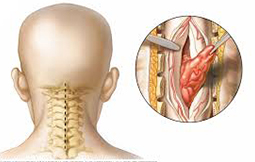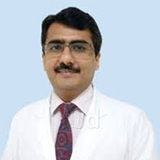
Get Free Treatment Plan From Top Hospital
Attach Medical Report
Spinal Cord Tumor- Types, Causes, Symptoms, Surgery, Treatment, Cost & Recovery
The spine is the column of bones placed horizontally, starting from the head and ending at the lower back section of the human body. The backbone or spine is a combination of vertebrae which again are several segments of bones. These vertebrae are separated by discs which act as cushions for shock absorption through the spine. A spine consists of 07 cervical, 12 thoracic, 05 sacral and 05 lumbar vertebrae and 3-5 (vertebrae) coccygeal. Tumour in the spine is removable completely if malignant. The treatment of spine tumours is affordable in India and usually is for patients suffering from constant pain due to the tumour. Tumour elimination also provides relief from severe complications such as body balance, walking, pain in the spine or neck, and improper bowel or bladder functions. Here you will know about spine tumor surgery cost, types, causes etc.
Spinal tumours are cancers that grow in the spine or bones of the spine. Spinal cord tumours, also known as intradural tumours, are tumours of the spinal cord that develop in the spinal cord or on both sides of the spinal cord (dural mater). Tumours that affect the bones (vertebrae) of the spine are called vertebral tumours.
Spinal cord injuries can be classified into three different types based on where they occur relative to the protective membrane of the spinal cord.
Important information about intradural tumours is as follows:
- Gliomas, astrocytomas, and ependymomas are examples of intramedullary tumours that start in the brain or spinal cord itself.
- Extramedullary tumours grow in the membrane surrounding the spinal cord or in the nerve roots coming out of the spinal cord. Although they do not arise from the spinal cord itself, these tumours can cause spinal cord compression and other problems affecting the spinal cord. Examples of extramedullary tumours that can affect the spinal cord include meningiomas, neurofibromas, schwannomas, and schwannomas.
Cancer that originated in another area of the body can metastasize (spread) to the vertebrae, the structure that surrounds the spine, and occasionally the spine itself.
Bone spurs or particular growths can cause pain, nerve problems, and sometimes even paralysis. Cancers can be life-threatening and cause permanent disability.
Spinal cord treatment may include surgery, radiation therapy, chemotherapy, or other medications.
Spine Tumour Types
There are many types of cancer, including:
- Meningiomas: These tumours originate in the meninges, which are the membranes that cover the brain and spinal cord. They are typically benign (non-cancerous) and slow-growing.
- Schwannomas: Also known as neurilemmomas, these tumours develop from the Schwann cells that surround and support nerve fibres. They are usually benign and can occur anywhere along the spine.
- Ependymomas: These tumours arise from ependymal cells lining the ventricles of the brain (filled with fluid) and the central canal of the spinal cord.
- Astrocytomas: Astrocytomas develop from star-shaped glial cells called astrocytes. They can be high-grade (malignant) or low-grade (benign).
- Hemangioblastomas: Rare tumours that develop from blood vessels are known as hemangioblastomas. They can develop in the spinal cord but most frequently occur in the cerebellum, a region of the brain.
- Chordomas: Remains of the notochord, a structure present during fetal development, give rise to these slow-growing, uncommon tumours. Although they can happen anywhere along the spine, they are most frequently found in the sacrum (bottom section of the spine).
- Osteosarcomas: These cancerous tumours, which start in the bone cells, are called osteosarcomas. They can happen in the spine but are uncommon.
- Lymphomas: The lymphatic system is where lymphomas, a type of cancer, grow. Both Hodgkin’s lymphoma and non-Hodgkin’s lymphoma can develop in the spine.
It’s vital to remember that these are only a few typical spinal tumour forms; additional, less typical varieties might also develop. Furthermore, spine cancers can be primary (starting in the spine) or secondary/metastatic (starting in another area of the body and spreading to the spine).
Spine tumour symptoms
Spinal cord symptoms depend on many factors, including:
- Where the tumour is in and along the spine
- How big the tumour is.
- What type of tumour it is.
Some spinal cord tumours cause no symptoms because they are too small to invade nearby tissues. However, when the tumour grows, it can cause some symptoms, especially pain.
Spinal tumour pain
The most typical symptom of both benign (non-cancerous) and malignant (cancerous) tumours is back pain. Pain from the spine in the middle or lower back is greater because the tumour will grow in areas of the spine.
Pain from a spinal tumour usually:
- It isn’t specifically associated with an injury, stress, or physical activity but can get worse with strain, such as from exercise, sneezing, or coughing.
- Is aching and deep.
- Starts slowly and gradually increases.
- It hurts at night and sometimes even disturbs sleep.
- Over time, it becomes intense and disruptive, even at rest.
- Pain management and not responding to medications.
Radicular discomfort, which radiates from the spine to the hips, legs, feet, or arms, can be brought on by cancer. Root discomfort frequently feels prickly and harsh.
Other symptoms of spinal tumours
Depending on the location and type of spinal cord injury, there may be other signs and symptoms besides pain. This usually happens when the tumour grows and presses on your spinal cord, nerve roots, blood vessels, or bones of your spine.
Other symptoms of spinal tumours include:
- Numbness, tingling, or loss of feeling in the legs, arms, or chest
- Muscular wasting in the arms, chest, or legs
- Muscle twitches or spasms
- Stiff back or neck.
- Avoid bowel and/or bladder control (abdominal and urinary problems)
- Difficulty walking, this may cause falls
- Scoliosis is another spinal deformity caused by tumours and/or damage.
- Paralysis may occur in varying degrees and in different parts of your body, depending on which nerves the tumour is compressing.
Spine tumour Treatment Options
Medical decisions are often multidisciplinary and combine the expertise of spine surgeons, oncologists, radiation oncologists, and other medical professionals.
Therefore, all aspects of the patient’s overall health and the purpose of care are taken into account when choosing both a surgical and non-surgical treatment.
Non-Surgical Treatments
Non-surgical treatments include observation, chemotherapy, and radiation therapy. Regular MRI can be used to identify and keep track of cancers that are asymptomatic or moderate and don’t seem to be changing or expanding. Radiation therapy is effective against some tumors while chemotherapy is effective against others. However, some types of metastatic tumours are inherently resistant to radiation (eg, colon and kidney) In this case; surgery may be the only treatment option.
Surgery
The need for surgery depends on the kind of tumour. Primary (non-metastatic) spinal cord tumours can be treated with the success of a definitive, potentially curative procedure. Treatment for patients with metastatic cancer is usually palliative with the aim of restoring or preserving neurological function, stabilizing the spine, and reducing pain. In general, surgery is an option only when patients with metastases need to live 3-4 months or longer and the tumour is resistant to radiation or chemotherapy. Indications for surgery include persistent pain, spinal cord compression, and the need to stabilize pathological damage.
In cases in which surgical resection is possible, preoperative embolization may be used to enable an easier resection. The procedure involves inserting a catheter or tube through a vein in the groin. An intravascular catheter is guided to the tumour site, where a gel-like liquid embolic agent is administered, which blocks the blood vessels feeding the tumour. The danger of surgery is lowered when the blood arteries feeding the tumour are stopped because bleeding is typically better managed during surgery.
If surgery is considered, the approach to the tumour is determined by the tumour’s location within the spinal canal. A posterior (reverse) approach can identify the dura and expose the nerves. This method is generally used for tumours on the back or tumours that expose the dura mater. Multi-level decompression can be performed and, if necessary, multi-level segmental fixation can be performed. An anterior (frontal) approach is ideal for treating tumours in the front of the spine. This method can also repair the defect by removing the vertebral body. This approach also allows the placement of short-segment fixation devices. Complete removal of breast and lumbar tumours affecting the anterior and posterior vertebrae can be difficult. Often these complex diseases are treated with posterior and personalized (anterior) procedures.
Further Spine tumour treatment options are as follows :
Our treatment approaches
The doctors in India know that your chances of successful treatment are best when your spine oncology treatment is treated with suitable to your unique situation. That is why Indian doctors customize treatments for you, including treatments in a condition with minimal impact on your body.
Treatment of spinal cord injury often requires surgery and surgery. The goal is removal of cancer much as possible without affecting the core of the spine and surrounding structures. It requires skill. Surgical skill is the key.
As with any surgery, breast cancer surgery is most effective when performed by specialists experienced in the particular procedure. If surgery is not possible or it is not possible to remove the entire tumour, we can treat the tumour with other treatments.
We are looking for new, safer and better treatments for cancer. It means we can present many new clinical trials for cancer.
Our therapies for spinal tumours
Your doctor will go over your best alternatives for treating cancer if you have received a diagnosis. It is dependent on a number of variables, such as the kind and location of the tumour as well as your general health.
To remove the tumour and treat its symptoms, one or more of the following therapies might be suggested
Corticosteroids
If the spinal cord is pressing on the spinal cord, these drugs (like dexamethasone) can be administered to relieve edema. Surgery is typically needed as soon as feasible for these tumours.
Some tumours can be surgically removed. Surgery will be followed by radiation therapy to shorten the spinal cord if all tumours cannot be removed. To shrink the spinal cord, radiation therapy may be used either before or after surgery. A sophisticated radiation therapy called stereotactic radiosurgery accurately targets the spinal tumour while having less of an effect on healthy tissue.
Targeted therapy
These new drugs are used to help fight certain types of spinal cord injury. Targeted therapies kill cancer cells by using small molecules to block the pathways cells use to survive and multiply.
Proton Therapy
Proton therapy delivers high doses of radiation directly to the tumour site without damaging nearby tissue. For some patients, this treatment provides better cancer control with physical intervention.
Clinical Trials for Spinal Tumors
It may be your best course of action in some cases. Sometimes they assist researchers in bettering current cancer treatments and understanding cancer therapies.
Spine tumour Risk and Complications
Cancer is more prevalent in those with:
- Neurofibromatosis 2. Benign tumours develop on or close to the auditory nerve in this hereditary disease. One or both ears may experience hearing loss as a result.
Spinal cord tumours can also appear in NF2 patients.
- The illness Von Hippel-Lindau Blood artery tumours (hemangioblastomas) in the brain, retina, and spinal cord as well as various forms of cancers in the kidneys or adrenal glands are linked to this uncommon, multisystem condition.
Spine tumour complications further include the following:
Depending on the location, size, and kind of tumour, there may be different spinal tumour consequences. Potential issues include the following:
- Compression of the spinal cord or nerve roots: Tumors that develop close to or inside the spinal cord may compress the nerves, causing pain, numbness, weakness, or paralysis in the afflicted area.
- Neurological deficits: Individuals may experience loss of motor function, coordination issues, trouble walking, or loss of sensation below the tumour level, depending on the severity of compression and injury to the spinal cord or nerve roots.
- Spinal instability: As tumours enlarge, they may weaken the spine’s bone components, creating instability and the possibility of fractures. It may result in abnormalities, spinal misalignment, and further nerve compression.
- Paralysis: A spinal tumour that substantially compresses the spinal cord may cause whole or partial paralysis below the tumour. A person’s mobility and functional ability may be greatly impacted by this.
- Dysfunction of the bowel and bladder: Spinal tumours can impair the normal operation of the nerve pathways that regulate bowel and bladder motions. It may cause faecal or urine incontinence, as well as trouble removing waste from the body.
- Progressive neurological function decline: In some circumstances, spine tumours can result in neurological function decline, which worsens symptoms over time.
- Infection: Due to impaired immune system function or structural damage to the spine, tumours may raise the risk of acquiring infections in the spine.
- Complications affecting the respiratory system: If a spinal tumour is in the upper cervical spine (neck region) or compresses the nerves that regulate the breathing muscles, it might cause breathing problems and respiratory compromise.
To reduce the risk of consequences, early detection and timely treatment of spinal tumours are crucial. Depending on the precise tumour characteristics and the patient’s general condition, treatment options may include surgery, radiation therapy, chemotherapy, or a combination of these modalities.
Spine tumour recovery time
Recovery time after spinal tumour removal:
Generally speaking, the recovery time after removing the tumour can take several weeks, months or even years. It does not matter what type of tumour it was, but this is the duration doctors will suggest for recovery after the removal. Healing is divided into several stages, and it is important to understand them.
Recovery phases after spinal tumour removal:
First few weeks:
When you get discharged from the hospital in the first week, you may face different problems. In a week or less, your doctor will discharge you from the hospital and begin medication for a few weeks. Medication timing is essential for recovery.
In the initial weeks, doctors will suggest you have a well-balanced diet with all the nutrients in it. The patient needs to be in touch with the doctor during the initial weeks so that they can easily diagnose the condition.
First few months:
When you have finished your first few weeks, you are now at the end of your healing process. A person will be able to carry out everyday tasks with ease, such as driving a car and walking. But it is essential to be attentive to the activities in which you are engaging. If a person has a cancer tumour, then chemotherapy is also in consideration. Therefore, check in with your doctor regularly.
In the first few months, your doctor will also schedule appointments with a physical therapist to maintain mobility and manage pain.
The first year:
It is right to conclude that starting at 12 months is very crucial for a patient, as is the need to pay attention to everything. Periodic imaging studies are required to detect the potential regrowth of the tumour.
The doctors will set it accordingly. The recovery period after spine surgery may be long, but if the person dedicates himself to everything, he will be able to get out of this process as soon as possible. You must pay attention to everything during recovery. Ask the doctor about what you can do and what you cannot.
This way you will have a better recovery time. Majorly, a person needs to follow medications, physiotherapy, and diet for a smooth recovery period. Rest is conditional and as recommended by your doctor.
Spine tumour best doctors and surgeons in India
The hospital’s neuro department has highly skilled doctors who have undergone extensive training and are experts in the field of neurological surgeries. These professionals understand the intricacies of brain surgeries and disorders and provide dedication to delivering personalized care to each patient. Al-Afiya is connected to the best doctors in India and can help people connect to them in a convenient way. Most of the doctors are internationally trained gaining expertise in modern methods and precision for the surgeries and treatments. The Al-Afiya Medi Tour team is available 24/7 to help international and national patients reach the doctor and hospital of their choice.
Below is the list of the few best spine tumour surgeons in India
Dr Ashish Sabharwal, Indraprastha Apollo Hospitals, Delhi
Dr Sanjay Sachdeva, Max Super Specialty Hospital, Delhi
Dr Gagan Gautam Max Super Specialty Hospital, Delhi
Dr Harsh Bhargava, Indraprastha Apollo Hospitals, Delhi.
Rajat Mahajan
Dr Aditya Gupta, Artemis Hospital, Delhi
Dr Sandeep Batra, Max Super Specialty Hospital, Delhi
Dr Bipin S Walia, Max Super Specialty Hospital, Delhi
Dr SKS Marya, Medanta The Medicity, Delhi
Dr Gurneet Singh Sawhney, Fortis Hospital Mulund, Mumbai
Dr Sonal Gupta, Fortis Hospital, Delhi
Dr Agnivesh Tikoo, Apollo Hospitals, Mumbai
Dr Ajay Herur, Apollo Specialty Hospital, Bangalore
Dr Anand Kavi, Apollo Spectra Hospitals, Pune
Dr Hamza Shaikh, Manipal Hospitals, Delhi
Dr Ashish Kumar Shrivastava, Dharamshila Narayana Superspeciality Hospital,
Dr Anurag Gupta, Sir Ganga Ram Hospital Delhi
Dr Dharmendra Singh, Max Balaji Hospital, New Delhi
Spine tumour best hospitals in India
The top hospitals in India take pride in their team of experienced oncologists and medical staff specialists for spine tumour treatment in India. The hospitals in India are well equipped with the latest medical technologies for providing excellent treatment for spine cancer in India. Al-Afiya Medi Tour has great connections with the top hospitals in India and can help you connect with them easily 24/7. The hospitals are present all around the country providing the best facilities and care for national or international patients. The hospitals have all the amenities and labs, radiology labs, scanning labs and other services available around the clock.
Below is the list of some of the best hospitals for spine tumour treatment in India
- Fortis Hospital Gurgaon
- Indraprastha Apollo Hospital New Delhi
- Apollo Hospitals, Greams Road, Chennai
- Fortis Escorts Hospital New Delhi
- Medanta – The Medicity, Gurgaon
- JAYPEE Hospital, Delhi
- Max Hospital, Delhi
- Artemis Hospital, Delhi
- Manipal Hospital, Delhi
- Apollo Hospitals, Hyderabad
- Kokilaben Dhirubhai Ambani Hospital Mumbai
- Artemis Hospital Gurgaon
- MGM Healthcare, Chennai
- MIOT International, Chennai
- BLK Super Specialty Hospital, Delhi
- Indian Spinal Injuries Center, New Delhi
Spine Tumour Treatment Cost in India
The cost of spinal tumour treatment in India can vary depending on various factors, such as the type and stage of the tumour, the hospital or medical centre, the surgeon’s fees, and any additional medical procedures or therapies required.
In India, the typical cost of a spinal tumour operation might be between INR 3 lakhs and INR 10 lakhs ($4,000 and $13,500). However, this pricing could not cover other expenses such as those for pre-operative exams, hospital stays, rehabilitation, and post-operative care.
It is important to remember that the price is simply an estimate and is subject to substantial variance. It is advisable to consult with a healthcare provider or a hospital to get accurate information about the cost of spinal tumour therapy in India.
Factors affecting the cost price (INR)
Pre-Surgery cost [Screening tests] Extensive Investigations (MRI, CT Scan, X-Ray, Blood test) – RS.10,000
Surgery cost including Spine Surgery to the patient Rs.2,00,000 – Rs.2,50,000
Bangalore Rs.1,00,000 to Rs.2,70,000
Hyderabad Rs.1,00,000 to Rs.2,00,000
Chennai Rs.1,00,000 to Rs.2,50,000
Delhi Rs.1,00,000 to Rs.5,50,000
Bangalore 2,50,000 to 3,70,000
Pune 2,50,000 to 3,70,000
Spine Tumour Success Rate in India
How successfully spinal tumours are treated in India, it can vary dependent on the type and stage of the tumour, its location, the patient’s overall condition, and the quantity of medical staff expertise. Though, India is home to many famous medical centres and skilled surgeons who specify in operating on spinal tumours.
In India, spinal tumour procedures frequently have a high percentage of success. Availability of contemporary equipment, medical staff skill, and cutting-edge medical technology all affect positive outcomes. The success rate for the incomplete or complete excision of spinal tumours may range from 70% to 90% depending on the exact situation.
The achievement rate may differ, so it is important to keep that in mind. It is also a good idea to see a medical professional who can assess each scenario individually and provide suitable leadership and treatment options.


If you are planning for Spine Tumor in India and searching for the best Spine Tumor hospital in India then no worries. Al Alfiya Medi Tour is ready for helping you. We have a team of experienced healthcare consultants. They will help you in finding the best hospital for Spine Tumor in India. You can choose any top Spine Tumor hospital in Delhi, Gurgaon, Faridabad, Noida, Chennai, Mumbai, etc. The list of Spine Tumor hospitals in the main cities- Delhi, Mumbai, Gurgaon, Noida, Faridabad, etc. in India with complete details such as hospital address, phone number, city, and best doctors list, etc. is given below. You can book an online appointment with any hospital now.
Book An Appointment for Spine Tumor

Get Free Treatment Plan From Top Hospital
Attach Medical Report

Medical tourism to India is on the rise because of the country’s low treatment costs, which attract people from all over the world. If you’re considering getting treatment for a spinal tumor in India, you’ll want to know how much it would cost. From hospital to hospital, city to city, and doctor to doctor, the cost of Spine Tumor treatment/surgery varies greatly in India. In order to get the precise cost of Spine Tumor surgery in India, feel free to contact us at any moment. Our healthcare specialists are here to assist.
In addition to helping you find the most effective therapy for your spine tumor treatment in India, we also work to keep the price of spinal cord tumor surgery within your reach. Interms of spine tumor surgery cost in India, an Indian surgeon charges anywhere from USD 4500 to $6500 (336757 to 486428 INR). A single session of radiation treatment for a spinal cord tumor treatment cost in India ranges anywhere from USD 1,000 to $3,500 (about 74949 to 262321 INR). Chemotherapy for the treatment of brain tumors like atypical teratoid /rhabdoid tumors, craniopharyngioma, and pineoblastoma may cost anything from $300 to $1200 each session (22365 to 89938 INR).

Spine Tumor success rate in India is very excellent. Although success rate depends on various factors such as hospital, doctor, patient, and many more. You can consult online with our healthcare professionals to know the success rate of Spine Tumor in India.
Contact Form
Attach Medical Report
Top Doctors & Sergions in India
Why Choose Us

Personalized Care
24x7 Supports
Top NABH and JCI accredited Hospitals
Free Cost Estimation & Medical Opinion from Specialist
Get Free Tele/Video Consultation
Visa and Traveling Assistance
Post-surgery with Assistance in Follow-ups
























